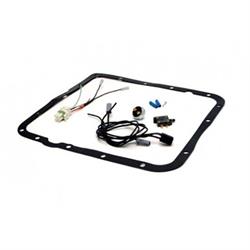Upgrading a 700R4 Transmission - 1967 Chevelle
Right out of the gate I have taken flack for wanting to use a 700R4 behind this big block. I have an ace in the hole though. I have an uncle with a transmission shop. I’ve used his services on every build I’ve done. On this build I had Uncle Chuck throw the book at it. Everything was upgraded from five pinion planetaries to the billet servo and a constant pressure valve body. This particular unit was a spare that I had laying around from another project. It was an early unit and less desirable due to its weaker 27 spline input shaft and other differences that GM rectified in the mid-eighties.
The bulk of Chuck’s focus was on the hard parts. The sun shell and planetaries were upgraded and everything was converted to the later 30 spline style. A hardened input shaft was employed and the 3-4 clutches were upgraded from stock replacements as well. One thing that’s killed more 700R4 transmissions than any other issue is heat. Most of the time this heat is generated as a misadjustment of the TV cable.
Internal pressures that are applied to the clutches are normally controlled by the throttle valve, TV valve for short. This valve is controlled by the TV cable that is attached to the arm on the carburetor or throttle body where your accelerator cable is attached. As the throttle is opened and the engine generates more power, ostensibly, this cable is pulled and applies more pressure internally to offset the load and engage the clutches harder. What happens is, the cable is either left unhooked or not adjusted tight enough and the transmission slips. Not to mention shifting early or erratically.
TCI has devised a work-around to this age-old issue. They produce an all-new valve body that provides 100% pump pressure regardless of the TV cable input. Shift points and passing gear kick-down are still controlled by the TV cable. Much like the older TH350, this adjustment is still important but won’t lead to the death of your new transmission.
Something else that was upgraded at the rebuild stage was a TCI Lockup Kit. This kit allows the use of a vacuum switch to disengage the highway speed lockup feature of the converter. I wired mine so that lockup can be fully disabled, over-ridden to stay locked up with throttle applied or to work normally and engage in fourth gear with light, steady throttle and to disengage when the throttle is applied.
Against Chuck’s advice, I painted my freshly built transmission. He doesn’t like this practice because it inhibits the aluminum case’s natural ability to dissipate heat and in 9/10 of the rebuilds he does, it doesn’t matter what the case looks like.
However, the Hotsy just doesn’t get all of the grime and gunk off an old case like this one. I started with a thorough application of masking tape on the input, stator and output shafts. I wrapped the billet piston case and taped it up. The lockup plug, dipstick and TV cable ports were also carefully masked off. Then I was able to lightly scrub the entire housing with a Roloc pad and my angle die grinder. Once I was satisfied with the surface, I wiped everything down with lacquer thinner. This helps ensure a clean and dry surface for painting. I chose to match the rear end housing and spindles with a metallic charcoal grey.
I picked a relatively high stall for a streetcar. My reason for this is two-fold, the dyno sheet and the advantage of a 3.06:1 first gear ratio. With peak engine torque of 578 lbft @ 3800 rpm, I want to be as close to that at launch as I can get. With a sticky tire, that should make for a thrilling experience in a foot-braked car. The concern I had was overcoming the large spread between first and the 1.63:1 second gear in the transmission. Keeping the flash stall speed high and the engine working in its happy place should help power past the wide-ratio drop. Torque gets it moving. Horsepower keeps it moving.

